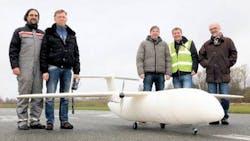Airbus Introduces 3D-Printed Mini Aircraft
BERLIN — Dwarfed by huge jets all around, the mini-plane Thor — the world’s first 3D-printed aircraft — was nonetheless an eye-catcher at the Berlin air show.
Windowless, weighing in at just 46 pounds and measuring less than 13 feet long, the drone Thor, short for “Test of High-tech Objectives in Reality,” resembles a large, white model airplane. Yet to the European aerospace giant Airbus, the small pilotless propeller aircraft is a pioneer that offers a taste of things to come — an aviation future when 3D-printing technology promises to save time, fuel and money.
“This is a test of what’s possible with 3D-printing technology,” said Detlev Konigorski, who was in charge of developing Thor for Airbus, speaking at the International Aerospace Exhibition and Air Show at Berlin’s southern Schoenefeld airport. “We want to see if we can speed up the development process by using 3D printing not just for individual parts but for an entire system.”
In Thor, the only parts that are not printed from a substance called polyamide are the electrical elements. The little plane “flies beautifully (and) is very stable,” said its chief engineer Gunnar Haase, who conducted Thor’s inaugural flight last November near the northern German city of Hamburg.
Airbus and its rival Boeing are already using 3D printing, notably to make parts for their huge passenger jets the A350 and B787 Dreamliner.
“The printed pieces have the advantage of requiring no tools and that they can be made very quickly,” said Jens Henzler of Bavaria-based Hofmann Innovation Group, which specializes in the new technology.
The metal parts produced can also be 30%-50% lighter than in the past, and there is almost zero manufacturing waste, added Henzler, who is managing director for Hofmann industrial prototyping.
The sky is not the limit for the technology; engineers also plan to use it in space.
The future Ariane 6 rocket of European space agency ESA, set to blast off from 2020, is set to feature many printed pieces.
“It brings big cost reductions on parts manufacturing,” said Alain Charmeau, head of Airbus Safran Launchers. The Ariane 6 may have half the price tag of its predecessor Ariane 5.
The new 3D printers can make pieces up to 15 inches long and is of most use in particularly complex designs.
Charmeau said Airbus is testing how to print an injection assembly for an engine that is now assembled from 270 individual pieces, which “with 3D printing,” he said, “has just three parts.”
Aside from the costs savings, 3D printing also promises ecological benefits as lighter jets use less fuel and spew out fewer pollutants.
To reducing carbon emissions in aviation — with air traffic expected to double in the next 20 years — “the decisive issue is radical technical innovation in a relatively short time,” said Ralf Fuecks, head of the Heinrich Boell foundation think tank of the German Green Party. 3D printing is certain to play a major role in this, he said at a conference at the ILA event with Airbus president Tom Enders.
The air travel industry is already convinced of the benefits, according to a survey of some 102 aviation sector players by German high-tech federation Bitkom.
Some 70% of respondents believed that by 2030 aircraft spare parts will be printed directly at airports, and 51% expect that entire planes will by then be manufactured by 3D printing.
By Marie Julien
Copyright Agence France-Presse, 2016
About the Author
Agence France-Presse
Copyright Agence France-Presse, 2002-2025. AFP text, photos, graphics and logos shall not be reproduced, published, broadcast, rewritten for broadcast or publication or redistributed directly or indirectly in any medium. AFP shall not be held liable for any delays, inaccuracies, errors or omissions in any AFP content, or for any actions taken in consequence.
